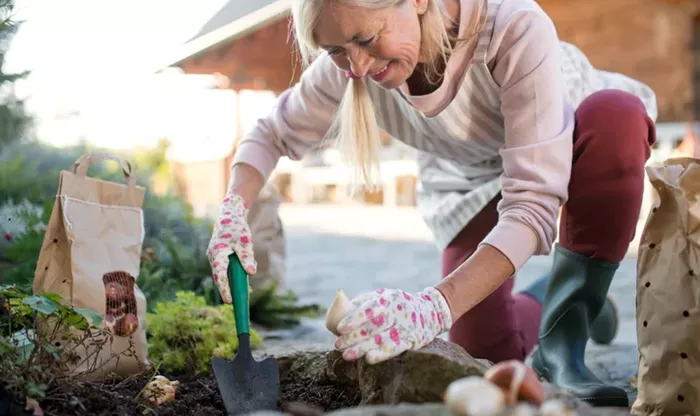For many gardeners, nothing is more exciting than seeing spring-blooming bulbs in full flower. These bulbs mark the start of the gardening season, bringing vibrant colors after the long winter months. Some gardeners prefer mixing various colors, while others choose specific palettes when selecting their bulbs. Among the most reliable spring bloomers are blue bulbs, which can fit well into many garden designs.
Planting Time
Most spring-blooming bulbs should be planted in mid to late autumn. Many blue flowers bloom early, such as crocuses, hyacinths, and bluebells. These can be planted near perennials that begin to grow as the bulbs’ foliage starts to die back. It’s important to check the bloom times of the bulbs before purchasing to ensure a well-designed spring garden.
Color Combinations
Blue bulbs pair beautifully with almost any color in the spring garden. Pale blue flowers look especially stunning alongside hot pink, red, or orange blooms. In contrast, darker blue varieties complement white, yellow, and lighter pink flowers. Drawing from my experience as a professional gardener, I’ve compiled a list of my favorite easy-to-care-for blue bulbs that can brighten your spring garden.
1. Squill
Also known as Siberian squill or blue scilla, squill is a popular heirloom bulb. It produces brilliant cobalt blue flowers early in the season. Plant these bulbs at the front of flower beds or throughout your lawn to create a stunning blue carpet in early spring. Their foliage dies back before it’s time to mow the lawn, making them a great option for adding color. Squill spreads slowly over time and thrives in partial shade.
2. Glory of the Snow
Glory of the Snow (Chionodoxa luciliae) are small bulbs that add vibrant color in early spring. They often bloom while there is still snow on the ground, making them a delightful sight. Despite their delicate appearance, they are hardy and increase in number over time. These bulbs bloom in shades of pale blue, white, pink, and lavender. Many gardeners enjoy planting mixed colors together.
3. Blue Grape Hyacinths
Grape hyacinths are easy-care bulbs that thrive in partial to full sun. Plant a few bulbs, and they will multiply over the years, creating large clusters of color. Occasionally, grape hyacinths may sprout foliage in late summer or fall, which can be easily divided. One notable variety is Muscari paradoxum, a taller option with greenish-blue buds. Other favorites include ‘Ocean Magic’ (pale blue and white) and Muscari latifolium (dark purple and blue).
4. English Bluebells
English bluebells (Hyacinthoides non-scripta) are often seen as the classic English flower. They can fill a forest with their enchanting blue-violet color. These bulbs prefer partial or dappled shade and well-drained, loamy soil. They are hardy in USDA Zones 4 to 9. Although they take some time to establish, they will gradually increase in number. Ensure you buy the correct variety, as they differ from Spanish bluebells.
5. Spanish Bluebells
Spanish bluebells (Hyacinthoides hispanica) resemble English bluebells but have slightly wider leaves and paler flowers. They also come in white and pink. These bulbs are hardier than their English counterparts, suitable for USDA Zones 3 to 8. However, they can be invasive, spreading through bulb division and reseeding. It’s best to plant or divide them in the fall.
6. Early Stardrift
Early Stardrift (Puschkinia libanotica) blooms early in spring and features white flowers with sky blue stripes. Also known as Russian snowdrops, they bloom around the same time as snowdrops. When planted in groups, they appear pale blue from a distance. Place them near the front of your garden bed to enjoy their spring display.
7. ‘Blue Diamond’ Dutch Iris
Dutch irises (Iris hollandica) bloom in mid to late spring. They grow tall, up to 2 feet, and have slender foliage. Unlike bearded irises, they do not spread through rhizomes but increase by producing clumps that can be divided and replanted in the fall. Notable blue varieties include ‘Sapphire Beauty,’ ‘Telstar,’ ‘Blue Ribbon,’ and ‘Blue Diamond,’ which features vibrant violet-blue flowers with a yellow center.
8. Crocus ‘Blue Pearl’
Crocuses are classic early spring flowers that push through the snow to provide color. Dutch crocuses have larger flowers, while species crocuses, like ‘Blue Pearl,’ come in beautiful colors, including pale yellow. Plant them near the front of your flower bed or throughout your lawn for a delicate display. They also look lovely paired with early-blooming yellow daffodils for contrast.
9. ‘Alida’ Dwarf Iris
Reticulated irises, or dwarf irises, grow only 6 to 8 inches tall and bloom just after snowdrops. Unlike other irises, they grow from bulbs. Plant them in the fall along with your other spring bulbs. The ‘Alida’ variety features shades of powder blue and yellow beards. Other blue cultivars include ‘Cantab’ and ‘Harmony.’
10. ‘Valerie Finnis’ Muscari
Most grape hyacinths (Muscari) are medium to dark violet-blue, but ‘Valerie Finnis’ stands out as a pale blue variety. Named after a famous British gardener, this cultivar will increase in number each year and provide lovely pastel blue blooms in your spring garden. They thrive in well-drained soil and can bloom in partial shade.
11. ‘Blue Jacket’ Dutch Hyacinth
Dutch hyacinths are beloved for their stunning colors and fragrant blooms. They flourish in full sun and bloom in mid-spring. Notable blue varieties include ‘Blue Jacket,’ which has dark blue stripes, and ‘Delft Blue,’ a pale periwinkle. Plant hyacinths in mid to late autumn, as they require cool temperatures for optimal growth.
12. Grecian Windflower
Grecian windflowers (Anemone blanda) feature daisy-like flowers in shades of blue, from periwinkle to sky blue. These hardy bulbs can withstand spring storms and are planted in the fall. Although they may take time to establish, they will bloom beautifully each spring. They are ideal for rock gardens and the front of borders.
Related topics:
- Arizona’s Plants Are Struggling in the Extreme Heat
- Why You Should Consider Cover Crops for Your Garden?
- Threats to Arctic Ecosystem Stability Due to Decreasing Plant Resilience


